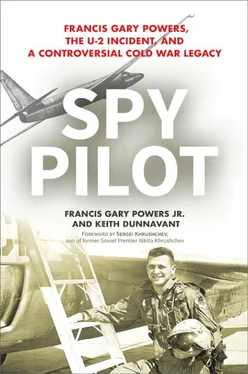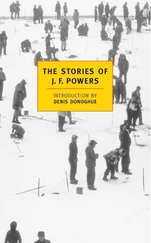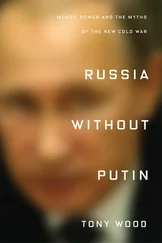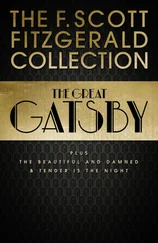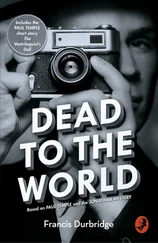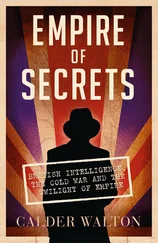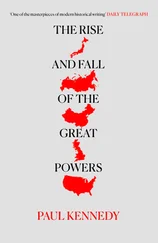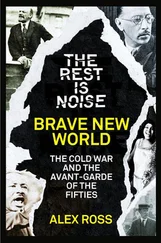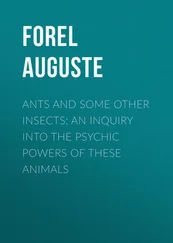The discussion was frank. At one point, someone asked Johnson why he thought he could get such a cutting-edge airplane in the air within nine months when other defense contractors insisted such a timetable was too ambitious.
“He has proven it three times already!” Putt interjected, referring to the P-80, P-80A, and F-104. 15
When the five men shook hands, Lockheed took a step into the shadowy world of espionage.
“I was impressed with the secrecy aspect and was told that I was essentially being drafted for the project,” Johnson wrote in his diary. 16
As the CIA took over security of the Skunk Works, sealing the perimeter with serious-looking plainclothes men carrying automatic weapons, and arranged to fund Lockheed’s $35 million contract through a dummy company, Kelly selected a special team and finalized his blueprints for a revolutionary aircraft. He started searching for an isolated place to test it.
The CIA refused to consider Edwards Air Force Base, the massive facility in California’s high desert where Chuck Yeager had broken the sound barrier in 1947, which transformed the once-dusty outpost into a center of test pilot activity; or the nearby Lockheed facility in Palmdale known as Plant 42. Both were secure, but not secure enough. The Company, as the CIA was known, wanted a new base where its new plane and new pilots could disappear.
LeVier suggested an isolated patch of dirt in Nevada. At the controls of a small plane on April 12, 1955, he gave the decision makers, including Johnson and the CIA’s Richard “Dick” Bissell Jr., their first glimpse of the area around a dry lakebed that was wide and straight enough for takeoffs and landings. “We didn’t even get clearance,” he said, “but flew over it, and within 30 seconds, we knew it was the place.” 17
Since it was located adjacent to the Nevada Test Site, where many of the early atomic bombs were exploded, with ominous mushroom clouds visible from the distant horizon, the land was not exactly prime real estate for civilian development. “Site was a dandy,” Johnson wrote, “but will take much red tape to get cleared.” 18This was Bissell’s problem, and he wasn’t worried. The proximity to the nuclear proving ground would make it easy for the government to deem the land off limits without too many questions being asked.
Several weeks later, the base, located at an altitude of about 5,000 feet, began to take shape with a 6,000-foot runway, two large hangars, a control tower, several mobile homes, and a mess hall. Because everyone involved with the project needed a top secret security clearance and was forbidden to even acknowledge its existence, the place became known in the shorthand of the pilots, engineers, and spooks as the Ranch, Watertown, Groom Lake, or, Kelly’s personal preference, Paradise Ranch. Only years later would it acquire its more mythical name, derived from the government grid system: Area 51.
“Whatever you called it, it was a pretty bleak place,” recalled Jake Kratt, one of the first CIA pilots brought into the program.
Bissell knew very little about airplanes, but he now had his own very special air base. A Connecticut-born aristocrat who had taught economics at Yale, his alma mater, Bissell was pulled into government service just before Pearl Harbor. Near the end of the war, he was part of the American delegation to the Yalta Conference in the Crimea, where a dying President Franklin Roosevelt, looking very frail, ceded domination over much of Eastern Europe to the communists. In time, historians would mark the spoils party as the prelude to the Cold War. Bissell came away understanding, long before the blockade of Berlin and the Soviet Union’s first atomic blast, that the wartime cooperation with the USSR was transactional and temporary. “I left Yalta knowing I would never believe Stalin to be an ally,” he said. 19
Work with the postwar Marshall Plan to rebuild Western Europe eventually led him to the CIA, where he became one of Dulles’s most trusted aides, slipping easily into a covert world where he was expected to fight a war in the shadows while keeping the country’s secrets. “There had to be a piece of him that was cold to do what he did,” said his son, Richard Bissell III, who learned about his father’s most famous accomplishments much later in life. 20“When you are in the business of getting a foreign leader out of a job—or killed—you have to be.” A devoted family man, he nevertheless compartmentalized his world, never letting his wife or children know exactly what he was up to when he was gone for weeks at a time. Like the rest of America, they had no clue about the U-2.
Headquartered at a front company operating out of a civilian office building on E Street near the Lincoln Memorial, and with complete authority over the CIA’s first foray into aerial reconnaissance and the clout to pull whatever strings Johnson needed yanked, Bissell did not need to be told that the White House expected him to produce with the aircraft, working under the code name Aquatone. His career was riding on Johnson’s ability to deliver on his bold promise.
Feeling enormous urgency, Johnson pushed his team relentlessly and leaned on contractors he saw falling behind schedule, especially the Pratt & Whitney people, who struggled to get the engine performing properly. “Terrifically long hours,” he said in one of his program log entries. 21“Everybody almost dead.”
While working through various problems with the power plant, tooling, electronics, pressure suits, aerodynamics, part fabrication, and wind-tunnel testing, the Skunk Works team negotiated the long road from the start of design to first experimental flight in just 243 days. The confidence Bissell and his closest associates—the Air Force liaison officer, Colonel Ozzie Ritland, and the CIA’s expert on the Soviet atomic program, Herbert Miller—gained in Johnson, which grew out of their close working relationship, allowed the agency to cede many details to him without micromanaging the Skunk Works, which significantly sped up the aircraft’s development. They hit what Bissell once considered an “almost unrealistic date” for the first flight. 22
Disassembled and loaded into a Douglas C-124 cargo plane for the short flight to the Ranch, the first U-2 was then reassembled in one of the new hangars. Some of the men involved with the program saw it up close for the first time on the runway.
The U-2 was a very different sort of aircraft. Powered at first by a J57 Pratt & Whitney engine, it featured very long wings, stretching more than 80 feet—nearly twice as long as the fuselage—which proved crucial in achieving the proper amount of lift to sustain flight at such a high altitude. When it was parked, the wings tended to droop, a feature exacerbated by a scaled-down set of landing gear—a so-called bicycle configuration, aided on takeoff with an extension known as a pogo, which dropped off as the plane left the ground. No one knew if the engine would operate effectively at such a high ceiling, or if it could cruise steadily enough to provide clear pictures from such an altitude. The whole project represented a step into the unknown.
To achieve the CIA’s objectives, including carrying enough fuel to reach the necessary range, Johnson had been forced to sacrifice significant strength and maneuverability. Realizing that every pound saved on the structure represented another pound of fuel, they built the craft out of an ultra-light aluminum, which gave it the feel of a flying tin can, helping it rise to previously unattained heights. The wings sometimes vibrated during turbulence, one of the attributes that could make it difficult to handle. Landing could be tricky, because of the enormous drag caused by the unusual design. “Very light, very fragile, very flimsy,” was LeVier’s initial observation. 23
Читать дальше
